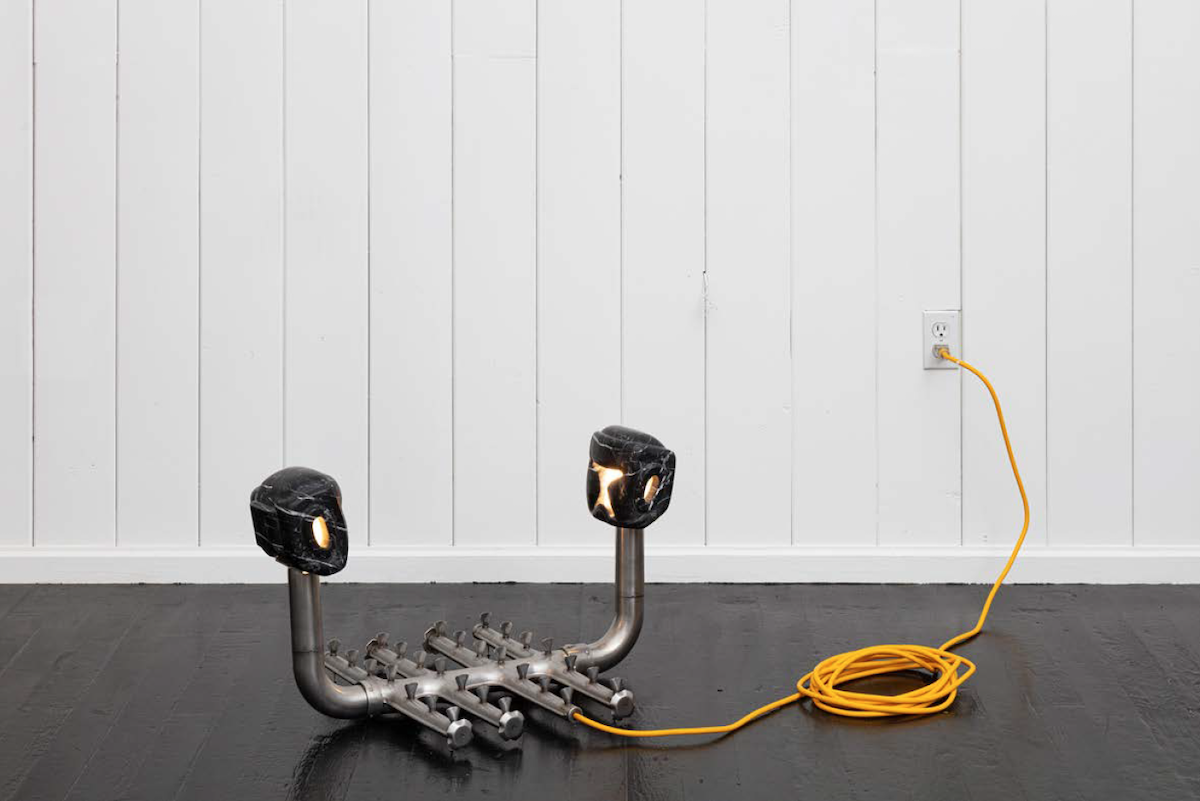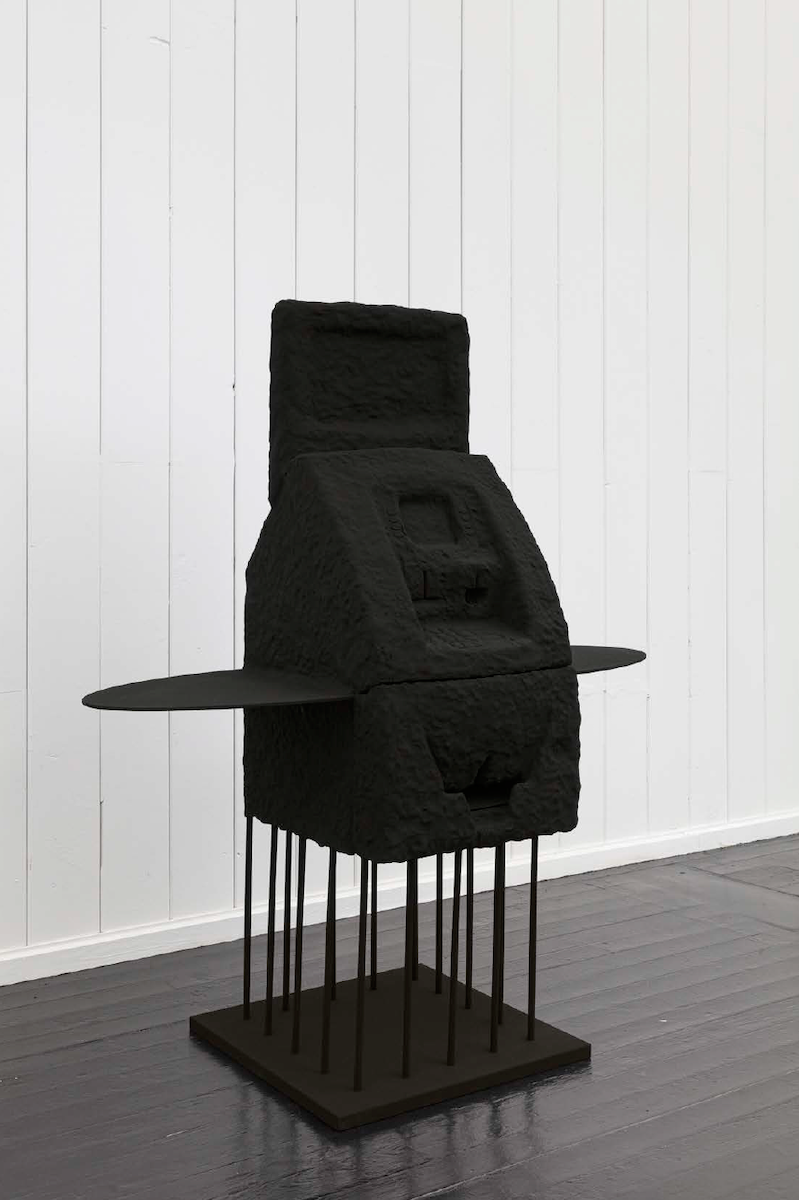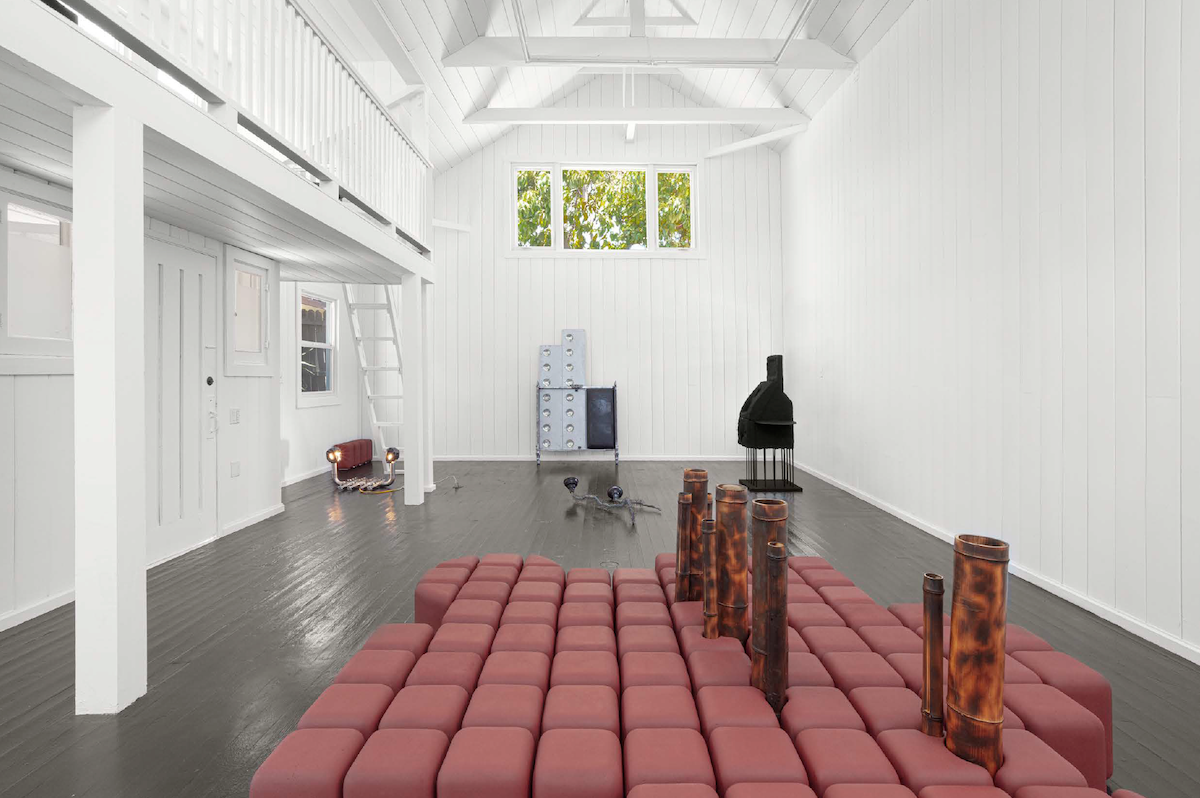The sculptures in Dozie Kanu’s first solo exhibition in Los Angeles flirt with functionality but refuse to reveal a clear purpose. Instead, these stylish hybrids possess the elegance of aspirational interior design and the subtle menace of dystopian relics. Many of the works contain familiar elements—a vintage headboard, an ATM machine, rubber plungers—but their relationship to our bodies is permanently transformed. The plunger heads are attached to spiky metal sticks—making them nearly impossible to hold. Meanwhile, the ATM machine stands covered in matte black clay, its buttons buried. These forms speak to recognizable material needs and domestic space, but the logic that binds these combinations remains poetic, not practical.
Sparsely installed in an airy barn-like structure, Kanu’s material choices invite close study. In trial foundation study for victorian revival (all works 2021), a few stalks of charred bamboo stick out from a large array of earthy-red blocks with rounded edges. The smooth bulbous bricks feel chic and futuristic while the bamboo recalls improvised structures built without steel reinforcing. Though uniform appearance, tiny imperfections in the surfaces of the pillow-like bricks indicate that they are sculpted and finished by hand. A rectangle of plywood lies on the floor next to this cluster, its flat face forming distinct wings of this tidy assemblage. After noticing a sliver of reflected light on the floor, I got on my hands and knees to inspect closer. Kanu placed thin steel plates beneath each block like a metallic coaster—a detail that feels integral to the character of the work even though it is nearly illegible. He also carefully notched the bricks to receive the sections of bamboo, neatly holding them in place. The peculiar specificity of these decisions lands like the syllables of a foreign language in which our comprehension is limited. These delightfully strange moments elicit curiosity, wonder, and excitement punctuated by occasional flashes of recognition.

Dozie Kanu, trial foundation study for victorian revival, 2021
trial foundation study for victorian revival resembles modular construction techniques, and a framed floorplan on a nearby wall adds specificity to the architectural allusions in the title. The outline of the structure depicted corresponds to the shape of Kanu’s sculpture and the labels on the rooms in this schematic contain markers of affluence—or at least suburban stability: “family room”, “breakfast nook”, and “two-car garage”. The comfortable proportions of this suburban home contrast with the lean aesthetics of Kanu’s sculpture, which manages to feel both luxurious and like an improvised prototype. The choice to reimagine the foundation of this particular home in a sculptural vocabulary feels personal but without nostalgia. Is this his childhood home? Or a home he coveted? Suburban developments are not known for innovative design, but they document how aspirations coalesce into physical structures. This pairing left me contemplating the seemingly paradoxical accomplishments of visionary architecture: structures that transform the scope of our dreams while responding to practical needs.

Dozie Kanu, Slessor 2.0, 2021
Elsewhere in the show, the artist’s juxtapositions strike a more confrontational note. Slessor 2.0 consists of a face-off between two small head-shaped masses that contain bright lights. Modeled on the type of sparring helmets common in martial arts, these hand-carved pieces of black marble are the size of grapefruits and nearly identical except for the pattern of delicate white veins running through the stone. These tiny helmets sit atop steel pipes that connect to a sinister-looking piece of found metal with two dozen openings in its parallel tubes—a gas burner it turns out. The scene is puzzling. Staring through the openings in the marble to determine the source of the light doesn’t yield any more information about the protagonists of this bizarre duel. A piece of frosted glass hides the bulb, and a fan somewhere inside hums continually (presumably cooling the lightbulbs). The individual components of this piece aren’t all that wild, but collectively they generate an unruly energy. This haunted appliance would certainly illuminate a room, but the intensity of its vibes would not be easy to live with.

Dozie Kanu, At The Moment, 2021
At The Moment is the most overtly political work in the show, and also the funniest. The sculpture is essentially an ATM machine covered in matte black clay with the artist’s fingerprints visible all over its surfaces. The cash machine sits atop what can only be described as a small prison cell—binding blackness to the racist machinery of carceral capitalism. Kanu’s transformation immediately evokes the predatory and exclusionary financial practices that form one of the sturdiest legs of white supremacy in this country. After all, this is the kind of ATM that you would find at a bodega, not the fancy touchscreen kind at the bank. Other aspects of the work are just plain silly. Oval-shaped wings protrude from either side of this tall box, as to propose that this defunct terminal might as well make itself useful and become a table. The dimpled clay coating also has the effect of making this banking device look plump and cartoonish—as if it were a racist but jovial Teletubby.
Kanu’s use of found objects brings a layer of complexity into the work without puncturing the ambiguity that makes his sculptures visually compelling. The success with which he integrates heterogeneous materials comes from the focus and restraint with which these elements are composed. Forging new aesthetic languages often requires cannibalizing the past, but the problems we address rarely change. Kanu’s enigmatic assemblages feel like relics from a future civilization whose hopes and fears mirror our own.
Dozie Kanu: “to prop and ignore”
Manual Arts, Los Angeles
May 6th – September 15th, 2021
Peter Brock is an artist based in Brooklyn, NY.

